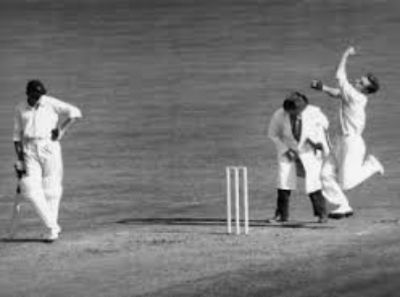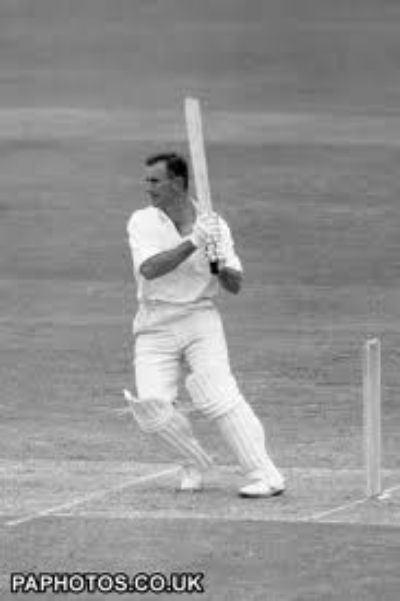ankitj
Cricket Web: All-Time Legend
This.Wicketkeepers are not allrounders. We need to dump this idea fast.
This.Wicketkeepers are not allrounders. We need to dump this idea fast.
If you have a keeper like Gichrist that can bat at 6 without the team loosing quality in their top 6 which allows you to play an extra bowler, for me he is an all rounder. He can play as a specialist batsman and he keeps wicket.This.

Lindwall began his career in 1946, and he retired in 1960. Unlike some Test bowlers his Top 10 victims during that time reads like a Who’s Who of cricket;Quick picks: Five all-time great fast bowlers who had pace as well as every trick in the book
Ray Lindwall heads my list of the five best fast bowlers I have seen.
This artist-cricketer changed his pace with all the subtle artifices any fast bowler of any era has achieved, and he did what all great bowlers must do: broke the rhythm of the batsman. At his peak he had the power to slay by thunder or defeat by guile.
Stocky and strong, Lindwall was like a well-toned welterweight, ready to punch and counter-punch. He bowled outswingers at genuine speed, and had what Pelham Warner called "shades of pace". To the purists, Lindwall's bowling arm was too low, but that helped his skidding bouncer. Instead of climbing harmlessly over the batsman's head, it came at the throat, earning him the nickname "Killer".
Ashley Mallett on the five best fast bowlers he has seen | Cricinfo Magazine | ESPN Cricinfo
Just love your write ups and the research you have obviously put in preparing them. Brilliantly written as well.
Australia's No.9: Ray Lindwall
Ray Lindwall is like Harold Larwood, Fred Trueman, Malcolm Marshall, Waqar Younis, and Glenn McGrath all rolled into one. He had an action identical to Larwood's, an outstanding outswinger like Trueman's, a bouncer that skidded through at throat height like Marshall's, a Yorker that dipped late like Waqar's, and pin-point accuracy like Glenn McGrath. This accuracy is reflected in the 794 wickets of his First Class career – 60% were either bowled or LBW.
The former Australian off-spinner though that Lindwall’s repertoire was so good that he rated him ahead of Dennis Lillee, Wasim Akram, Alan Davidson, and Malcolm Marshall;
Lindwall began his career in 1946, and he retired in 1960. Unlike some Test bowlers his Top 10 victims during that time reads like a Who’s Who of cricket;
Dennis Compton (10)
Godfrey Evans (10)
Len Hutton (9)
Bill Edrich (8)
Vinoo Mankad (8)
Cyril Washbrook (7)
Alec Bedser (7)
Trevor Bailey (7)
Clyde Walcott (5)
Peter May (5)
Yet despite frequently playing against quality opposition he was able to maintain exceptional figures. After 20 Tests his bowling average was 18.98, and at the end of 40 Tests it was 20.7. Only after his very last Test match did his average creep over the 22 mark to finish at 23.03. His Strike Rate was consistently in the mid-50s for most of his career, and never touched 60 balls per wicket except for his initial test matches in 1946. Against England he was successful home and away, and finished with 114 wickets at 22.44. His best bowling performance came at The Oval in 1948 when he he took 6 for 20 to help dismiss England for 52 in their first innings. Arthur Morris responded with an innings of 196 runs as a prelude to England being routed again on Day 4.
Ray Lindwall was also a creditable lower order batsman. Against England he scored a century and four 50s, and averaged 22.08. As well as being an ATG bowler his batting skills will add some useful depth to the Australian line-up.
And yet he never seemed to, even when Australia were desperately searching for a way of getting a 5th bowler into their line-up.If you have a keeper like Gichrist that can bat at 6 without the team loosing quality in their top 6 which allows you to play an extra bowler, for me he is an all rounder. He can play as a specialist batsman and he keeps wicket.

The ‘Wisden Overview’ of Dexter begins;At No 3, you’ve got to have Ted Dexter. He was a fantastic player who stood up well to the quicks. Ted could easily get bored against medium-pace trundlers but he was stimulated by a real challenge — and Lillee and Thomson were always that.
The Ashes 2010: Geoffrey Boycott picks his all-time England and Australia teams - Telegraph
In this England side Barrington will follow immediately after Dexter in the batting order. This is because Dexter and Barrington clearly liked batting together. During their 36 partnerships they averaged 66.61 per innings (6 x 100s and 11 x 50s). When Dexter batted in the No.3 position their average was slightly better at 73.31. To put this into perspective, Dravid and Tendulkar partnerships are worth 50.51 runs each.There was no more exhilarating sight in English cricket than Ted Dexter when he was savaging fast bowling. Though he had the patience and technique to develop a long innings or fight a rearguard action according to the position of a match - six of his nine Test hundreds were bigger than 140 - it was the naked power of his driving on the counter-attack that fired the imagination….
All good points, so now you're confusing meNot sure of the England number 6, could be Botham (or Grieg).
Number 6 for Australia will be interesting. Picking Lindwall at 9 indicates the Australian Number 8 can bat as well (Benaud, Davidson, Miller)
Australia
06. Miller / Waugh / Armstrong
07. Gilchrist
08. Benaud / Davidson / Miller
09. Lindwall
10. Warne ???
A 6 - 11 of say Miller, Gilchrist, Benaud, Lindwall, Warne is a very dangerous middle / lower order and could score 200 runs on there day.
On the other hand Simpson, Chappel, Border where all useful bowlers (between them they averaged 1.5 -> 2 wickets a Test), add Steve Waugh and you have your "Batting allrounder".
I will guess Miller and Benaud for 6 / 8 for Australia. Given that Australia has Bradman + Gilchrist and 8 / 9 (and probably 10) batsment who could bat, I do not see the need for a specialist Batsman at 6.
Having 5 ATG bowlers is a huge advantage. In a genuine 5 man attack, on most days 4 bowlers will do most of the bowling but it will be a different set of 4 bowler's each day depending who is bowling the best on that Day. Having 5 ATG bowlers improves the consistency of the Bowling, there is no bowler you can rest against.

Out of Armstrong and Noble, I prefer Noble.It just seems as though Armstrong struggled in England (24.64, 2 50's in 31 inns,) compared to belting them around in Australia (43.59, 4 100's, 4 50's 40 inns).
So even though they aren't comparable to covered pitch stats, it does indicate he had a tougher time over there.
